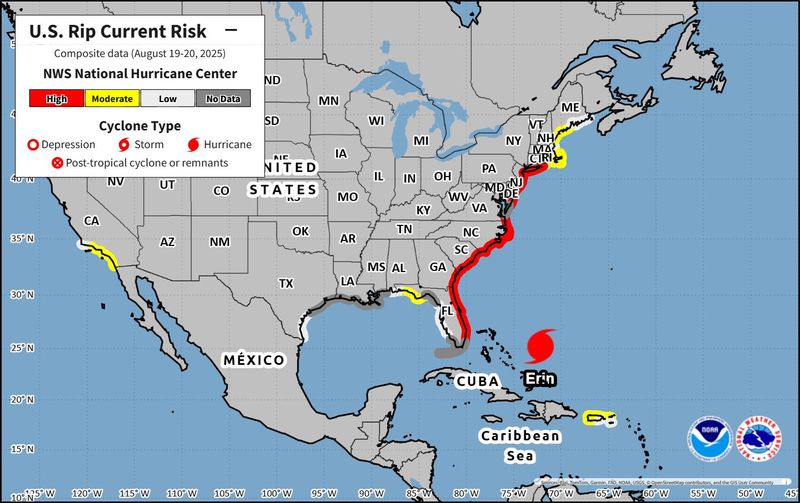
Beachgoers in multiple East Coast states are being advised to take extreme caution as large waves and life-threatening surf and rip current conditions from Hurricane Erin are expected over the next couple of days.
Evacuations were underway along parts of North Carolina's Outer Banks, a big draw for vacationers every summer. With Erin's expected storm surge and waves of over 10 feet, the National Weather Service is urging people to stay out of the ocean to avoid deadly surf conditions expected through at least Aug. 21.
Officials in Dare County, North Carolina, declared a state of emergency, effective as of 6 p.m. ET on Aug. 17, and issued a mandatory evacuation for Hatteras Island.
"While Hurricane Erin is expected to stay well off our coast, the system will continue to increase in size and is forecast to bring life-threatening impacts to the Dare County coastline," officials said in an Aug. 17 news release. "Coastal flooding and ocean overwash are expected to begin as early as Tuesday, Aug. 19 and continue through Thursday, Aug. 21," officials said, noting that portions of North Carolina Highway 12 on Hatteras Island will likely be "impassable" for several days.
Cape Hatteras National Seashore said in a news release on Aug. 18 that it had closed beach accesses and facilities, adding that visitors should "stay off the beaches completely and discontinue use of all beach trails and boardwalks beginning Tuesday morning."
In neighboring Hyde County, a mandatory evacuation order went into effect Aug. 19 for Ocracoke Island.
Authorities in North Carolina said about 60 people had to be rescued from rip currents at Wrightsville Beach, prompting a no-swim order through the rest of the week, according to the Wilmington Star-News, part of the USA TODAY Network.
Another individual was rescued from rip currents at a South Carolina beach, and a dozen rip currents were reported at South Carolina and Georgia beaches on Aug. 18, the National Weather Service in Charleston, South Carolina, said.
Beaches in Delaware and along the Jersey Shore were closed to swimmers on Aug. 19, with closures affecting beaches such as Wildwood, Margate and Bay Head. At Island Head Beach State Park in Berkeley Township, New Jersey, swimming, surfing, boogie boarding, mobile sport fishing vehicle permit access and nature center programs are suspended through at least Aug. 21.
New Jersey Gov. Phil Murphy urged visitors and residents to avoid wading or swimming in the ocean, citing the dangerous rip currents and high waves.
How to stay safe from rip currents
Rip currents kill dozens in the United States every year, according to data from the National Oceanic and Atmospheric Administration (NOAA). Since 2010, more than 800 people have died in rip current drownings. As of late July, at least 52 people died from surf zone dangers, nearly half of which were rip current drownings, the data shows.
A rip current is a fast-moving channel of water that flows away from the shore and can drag a swimmer out into the ocean. The narrow, strong currents flow quickly and perpendicular to the coastline.
Rip currents are so dangerous because they can catch swimmers off guard and cause them to panic while trying to swim to shore. The exertion causes fatigue before they can break free from the current, which continues to pull them out, experts say.
According to officials, you should check for any warnings before entering the water and keep an eye on the weather and water conditions. Additionally, always swim near a lifeguard.
If you do end up caught in a rip current, try to remain calm. The current won't pull you under; it will just pull you away from the shore. Don't swim against the current, because you'll risk tiring yourself out; instead, swim parallel to the shore and then swim back to land at an angle once you're free of the current.
If you see someone else struggling in a rip current, you should try to get help from a lifeguard, according to NOAA's Rip Current Survival Guide. You can also throw something that floats to the person while you find a lifeguard. If there is no lifeguard on duty, call 911. Do not enter the water to try to help; experts say people who try to help often get caught in rip currents themselves.
Gabe Hauari is a national trending news reporter at USA TODAY. You can follow him on X @GabeHauari or email him at Gdhauari@gannett.com.
This article originally appeared on USA TODAY: Which beaches are closed due to Hurricane Erin? Here's what we know
Reporting by Gabe Hauari, Jeanine Santucci, Dinah Voyles Pulver and John Bacon, USA TODAY / USA TODAY
USA TODAY Network via Reuters Connect

 USA TODAY National
USA TODAY National
 WCVB-TV Boston
WCVB-TV Boston ABC 7 NY
ABC 7 NY FOX News Travel
FOX News Travel America News
America News CBS News Video
CBS News Video WCNC Charlotte Weather
WCNC Charlotte Weather The Atlanta Journal-Constitution Crime
The Atlanta Journal-Constitution Crime CBS News
CBS News YourTango Horoscope
YourTango Horoscope